
According to the National Chicken Wing Council, Americans are projected to eat 1.45 billion chicken wings this Super Bowl weekend, spurred on by prices that are down 22% from last year. But hey, I’m not a wing economist. I’m not investing in chicken futures. I’m just a guy covered elbow-to-fingertips in buttery orange sauce.
Why so buttery? Well, seeing as how chicken wings are to Super Bowl weekend what turkey is to Thanksgiving, I thought this would be a great time to test out some of the internet’s most popular chicken wing recipes and… maybe see if we could improve on them.
When people think NFL and wings, they naturally think Buffalo Wings (maybe some day people will hear “Buffalo” and think “Super Bowl,” but alas…). Unlike a lot of our favorite foods (pizza, hot dogs, hamburgers, apple pie) Buffalo Wings are a food with a lineage that can be traced back specifically to the USA. Teressa Bellissimo, a Sicilian-born bar owner in Buffalo (so the story goes), invented the Buffalo Wing at Anchor Bar back in 1964, when, rather than using them for stock or tossing them out as people often did with chicken wings back in those days, she deep fried some and served them up with a sauce made from cayenne pepper hot sauce and butter.
These days, you could make a case that Buffalo Wings are actually a more popular export than American football itself.
The “original” Buffalo Wing was deep fried and unbreaded, and the ratio of bone-to-meat does make the wing uniquely suited to being fried. Ever tried frying a turkey leg? Takes forever to get the inner meat cooked and by the time you do, the outside is burnt and drying out. Chicken wings are idiot-proof by comparison.
These days, a “Buffalo Wing” is just one variant of the overall wing phenomenon. Pok Pok in Portland, Oregon, got famous for their Vietnamese fish sauce wings. Hot Sauce and Panko, in San Francisco, is one of many wing joints specializing in Korean-style fried chicken (which some claim made its way to Asia by way of Black American soldiers). And of course, fried chicken joints like Popeye’s et al have been slinging wings for years.
The beauty of the wing is that you can cook it in all sorts of ways and it’s usually pretty good. Unbreaded is the “original” Buffalo style, but it’s hard to turn down a breaded wing. You can also bake them, baste them in a pan… hell, that’s why we’re here, right? It’s time to compare and contrast!
For this piece, I decided to find the most popular wing recipes from Google, YouTube, and TikTok to prepare them, rate them, and then maybe see if we could improve them. I was worried that I’d be splitting hairs, but it just so happened that each recipe had its own unique cooking style, allowing us a decent cross section of wing-cooking methods without going too crazy.
As with virtually all online recipes, you can read on to go on this beautiful journey of self-discovery with me, seeing how I arrived at each decision, or you can metaphorically spit in my face and just scroll all the way to the bottom for my hacked recipe(s). Whatever, man, it’s your life.
The TikTok Recipe – AKA, “Double Breaded, Double Fried”
@thegoldenbalance Throwback To My Favorite Wing Recipe
#thegoldenbalance
As of this writing, The Golden Balance on TikTok here has about 294,000 views on this wing recipe. Putting aside the lack of specifics (no video descriptions here) and Gen Z house style (brashly obnoxious, with barely-justified act-outs, hair dangling foreword across the forehead), this is actually a pretty solid recipe.
But I’m getting ahead of myself.
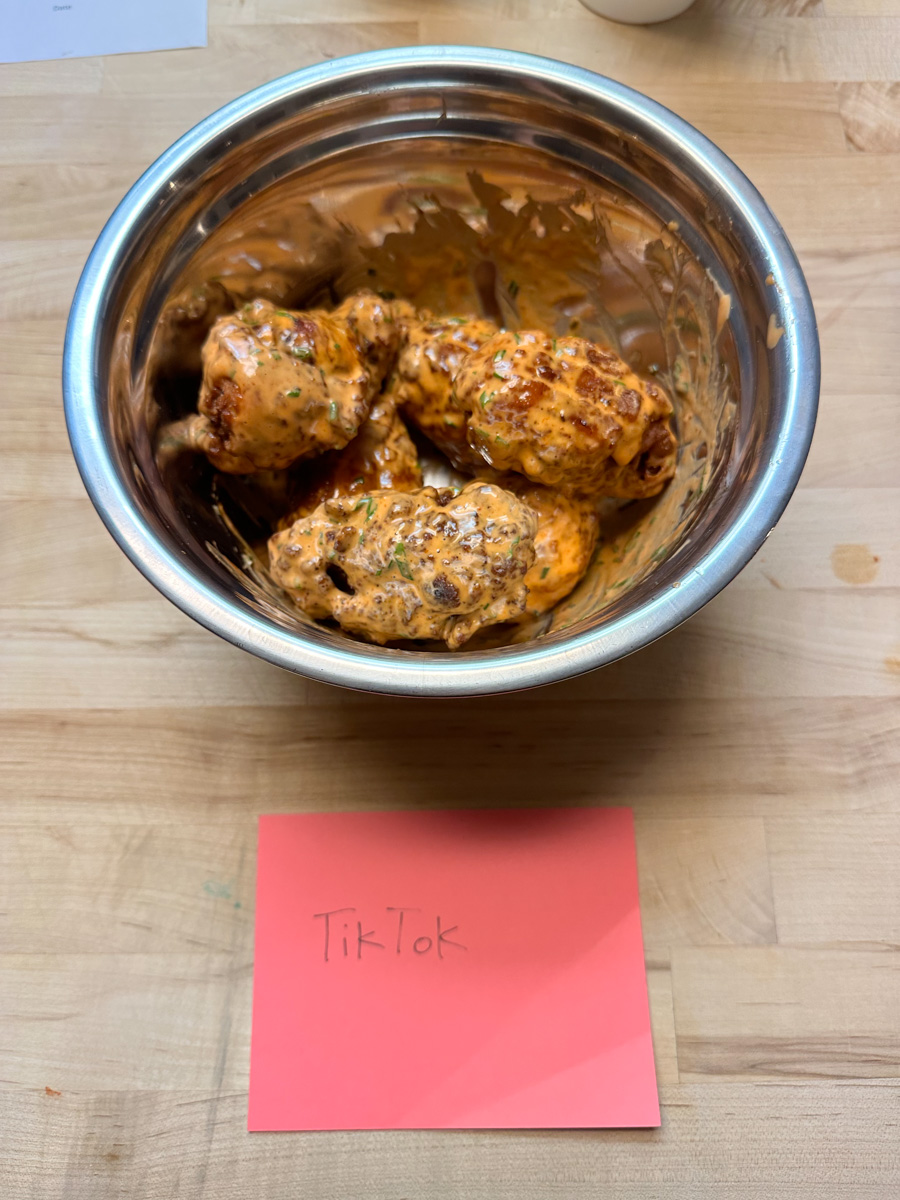
The Cliff’s Notes
-Marinated overnight in seasoned buttermilk
-Double breaded in seasoned breading — rice flour and potato starch
-Double fried: once at 315 for six minutes, then rested and refried for “just a couple more minutes” at 375.
-Sauced with a mix of Sriracha, honey, and Kewpie mayonnaise, and chives
Pros & Cons
PRO:
The overnight marinade (in a pretty traditional southern buttermilk brine) is a smart move. I’m of the belief that if you can season your meat overnight, you should pretty much always do it. He doesn’t specify spice blend, but I used a pre-made seasoning blend that had onion, garlic, pepper, and MSG.
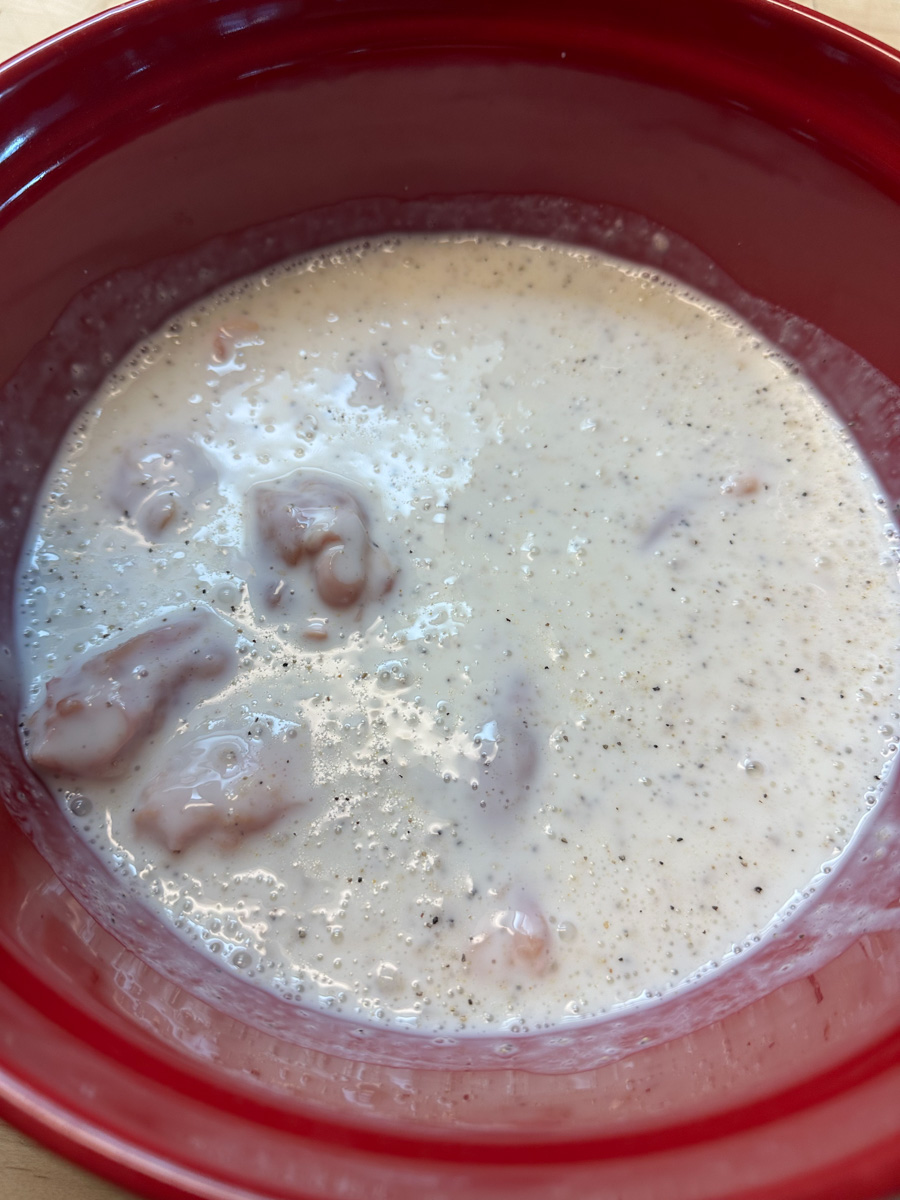
PRO:
It’s hard to beat a breaded wing. And double-frying is a great way to ensure the wing is cooked well but also cooked evenly. It’s a beautiful marriage of crisp and moist. I’ll never forget the way Top Chef‘s Shota Nakajima explained his chicken karaage to me:
I would say double frying is the biggest thing. I think of it almost as a steamed dish(…). You want to make sure the batter is on the outside correctly(…). If it’s coated, that means there’s this whole layer of breading on the outside, and the ingredient itself isn’t touching any cooking heat. It’s steaming on the inside. So that’s how you keep it juicy. But once you cook and you let it rest, that’s when the moisture gets pulled out. So you want to let it rest and get that moisture to get pulled out more and then fry it so you can hold that crispy edge.
PRO:
The sauce is great, a nice mix of spicy, sweet, and creamy (without any butter) and, unlike Buffalo sauce, I had no trouble keeping it emulsified.
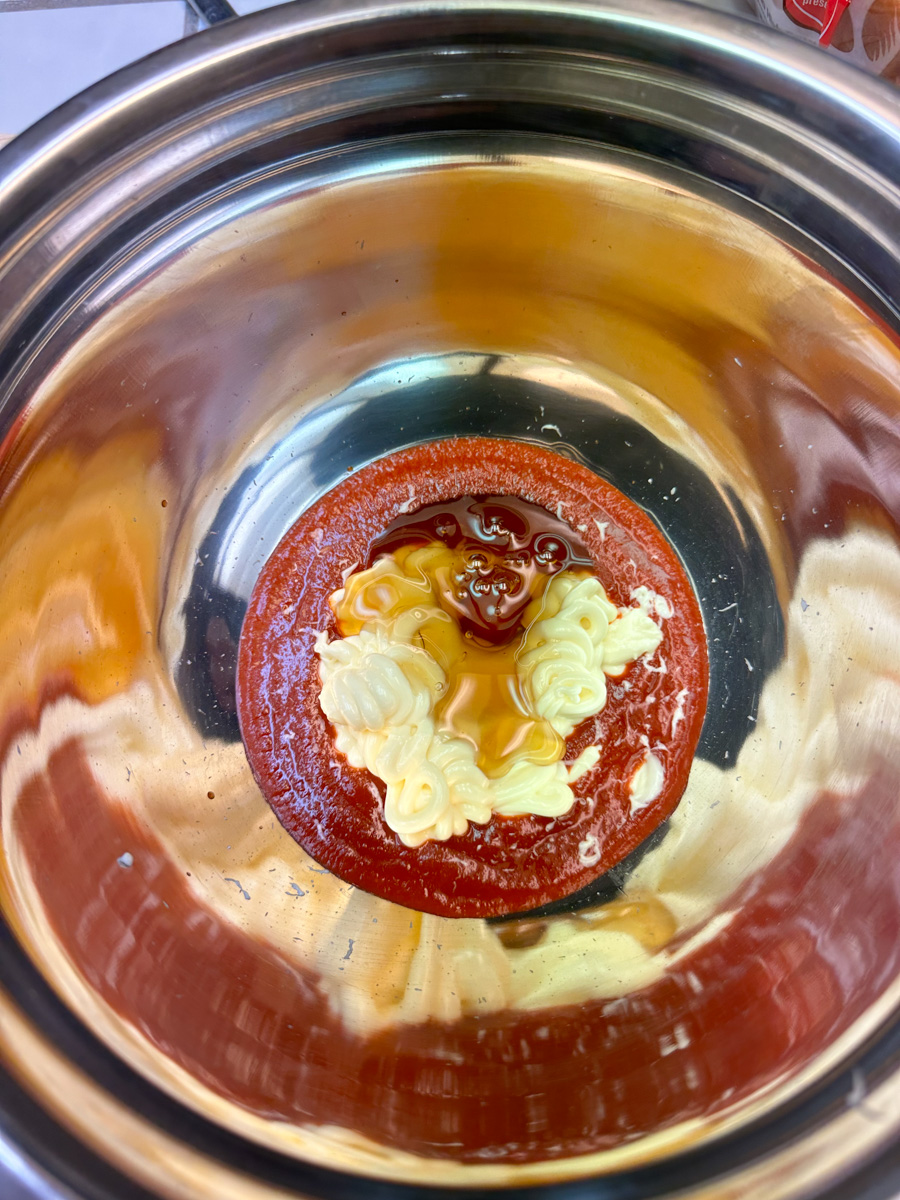
These wings are also HEAVILY breaded and extremely crispy, to the point that I thought they would destroy the roof of my mouth. Without the sauce, they definitely would. But this sauce softens the breading just enough so that it’s still crunchy but won’t draw blood.
CON:
Double breading is too much breading.
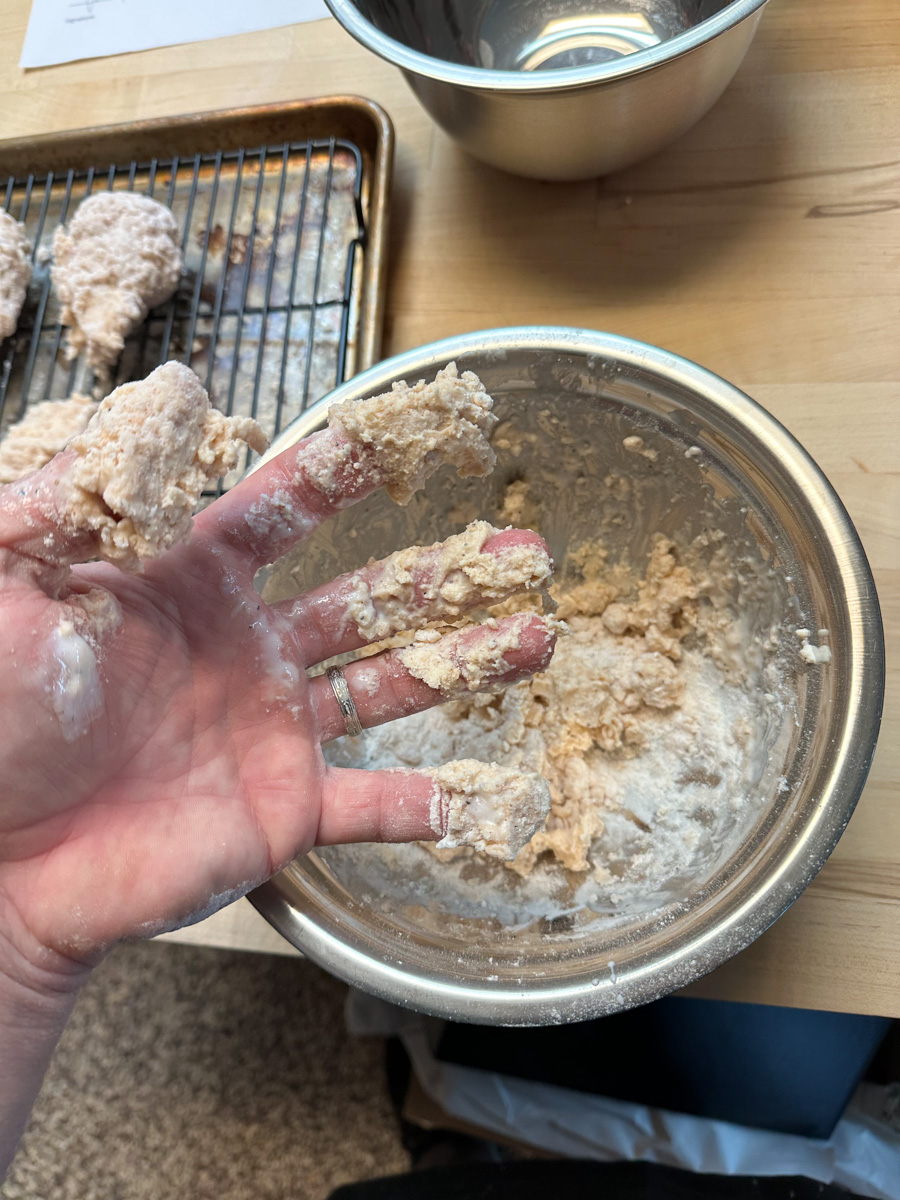
Clearly, I got a little messier than the TikTok guy.
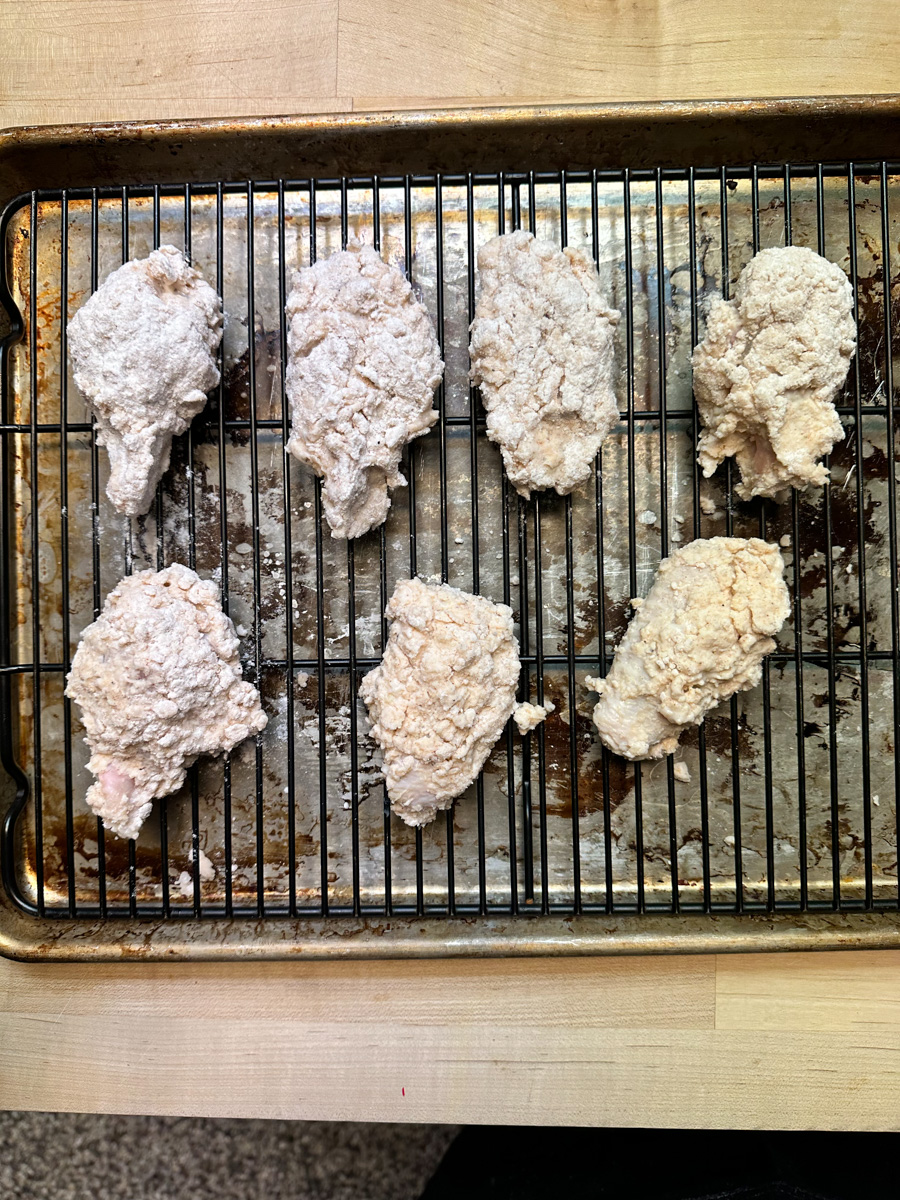
That’s a lotta breading, yo.
That whole “wet dry, wet dry” thing he describes sounds a lot breezier than it actually is. When I did that, I ended up with like half an inch of breading on the chicken. And with a half rice flour batter, that seemed… daunting. I thought this was going to be like biting into a chicken who had covered his wings in glue and broken glass like some kind of chicken Bloodsport situaish.
That mayo-based sauce isn’t just a condiment here, it’s a safety precaution.

CONS:
Frying is still a pain in the ass. When you fry, you’re going to be dealing with a bunch of frying oil, a frying vessel, a draining setup… etc. I got rid of my deep fryer a few years back so I had to use a cast iron fry pan, but even with a home deep fryer, you’re only going to be able to get, what, six wings in there, max? Plus, with a fry pan there’s a lot of guesswork with the temp. I put them in at 340 or so and then the temp goes down before 300 so I’m cranking it back up… it’s a lot of fiddling.
Was it worth it? We’ll get to that in a sec.
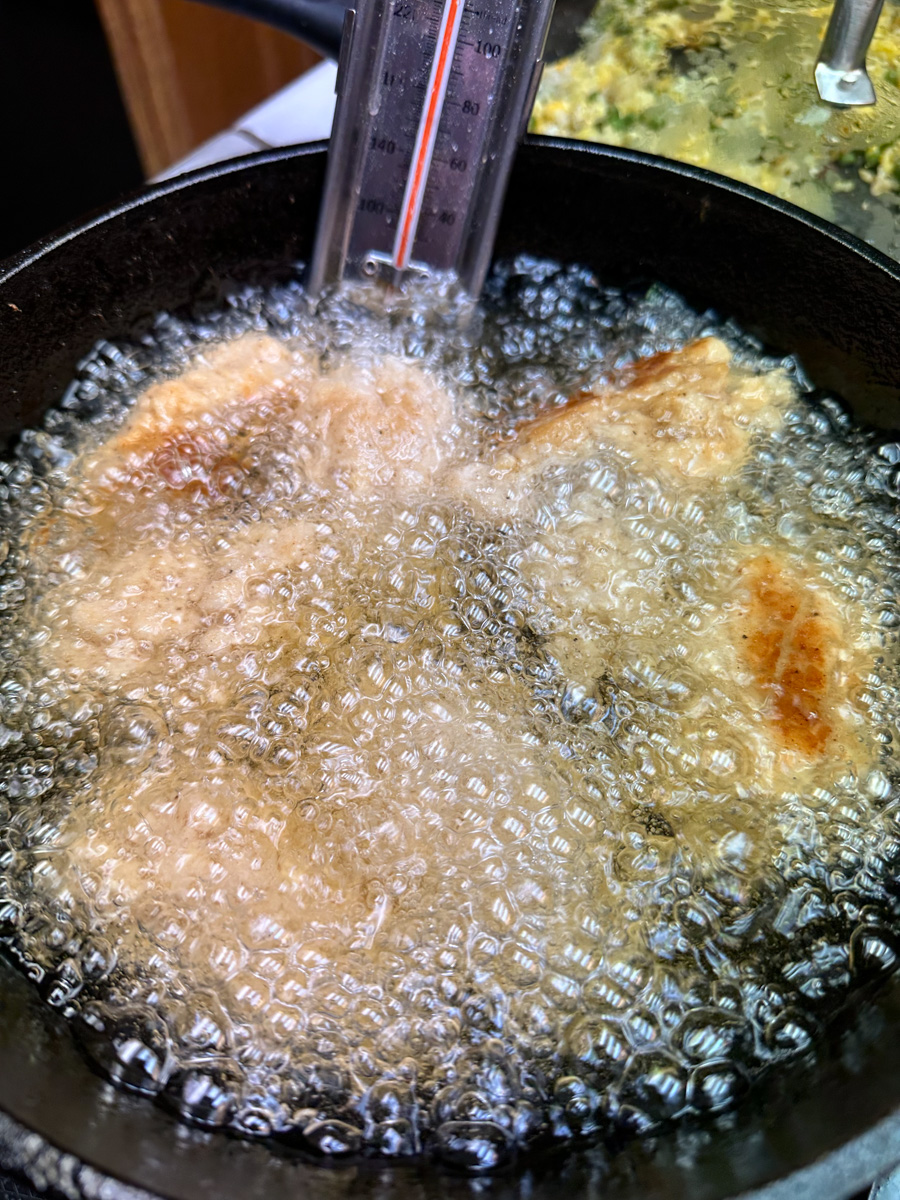
The Google Recipe — AKA, Hammered & Buttered.

This recipe, from CafeDelites, was a top result and a top-rated recipe on Google.
The Cliff’s Notes:
-Lightly breaded in baking powder (aluminum-free), garlic powder, salt, and pepper.
-Option to season overnight
-Tossed in traditional Buffalo sauce (half cayenne pepper sauce, half butter)
-BAKED on a wire rack at 450F, for 30 minutes per side.
Pros & Cons

PRO:
Baking is probably the easiest, least equipment-intensive method of cooking wings. You can do a lot at one time and the cleanup is pretty easy.
PRO:
A light, baking powder-based breading left to dry overnight does an adequate job mimicking a fried, unbreaded wing. They came out with a really roasty, rendered chicken skin flavor. They taste golden brown.
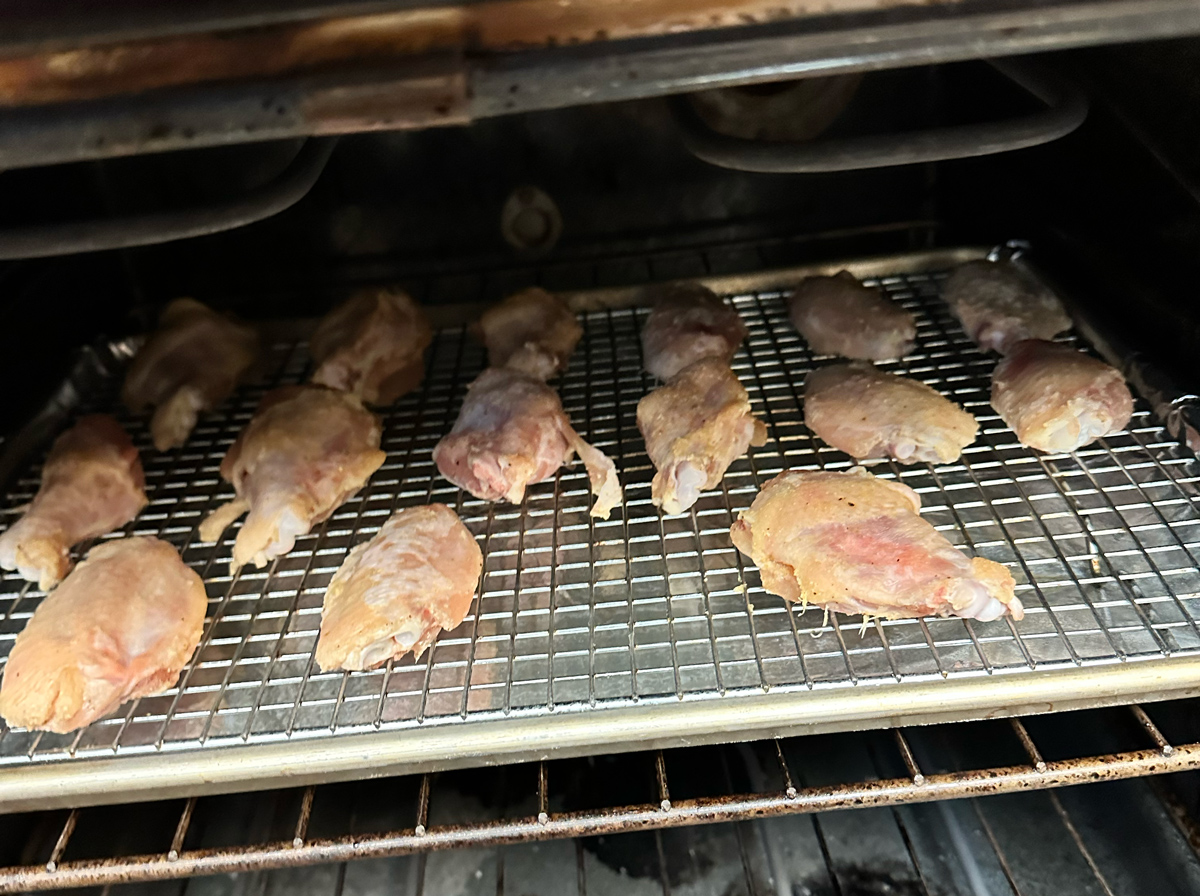
PRO:
Traditional Buffalo sauce is indeed delicious. You can get fancier with sauces, but it’s hard not to love a butter-and-hot-sauced-drenched wing. You’re always going to eat more of them than you tell yourself.
CON:
I don’t know if the CafeDelites people had much bigger chicken wings than I did, but at 50 minutes (I actually pulled these earlier than the recipe suggested) these wings were absolutely hammered. They were nice and crispy but definitely sort of dry and stringy.
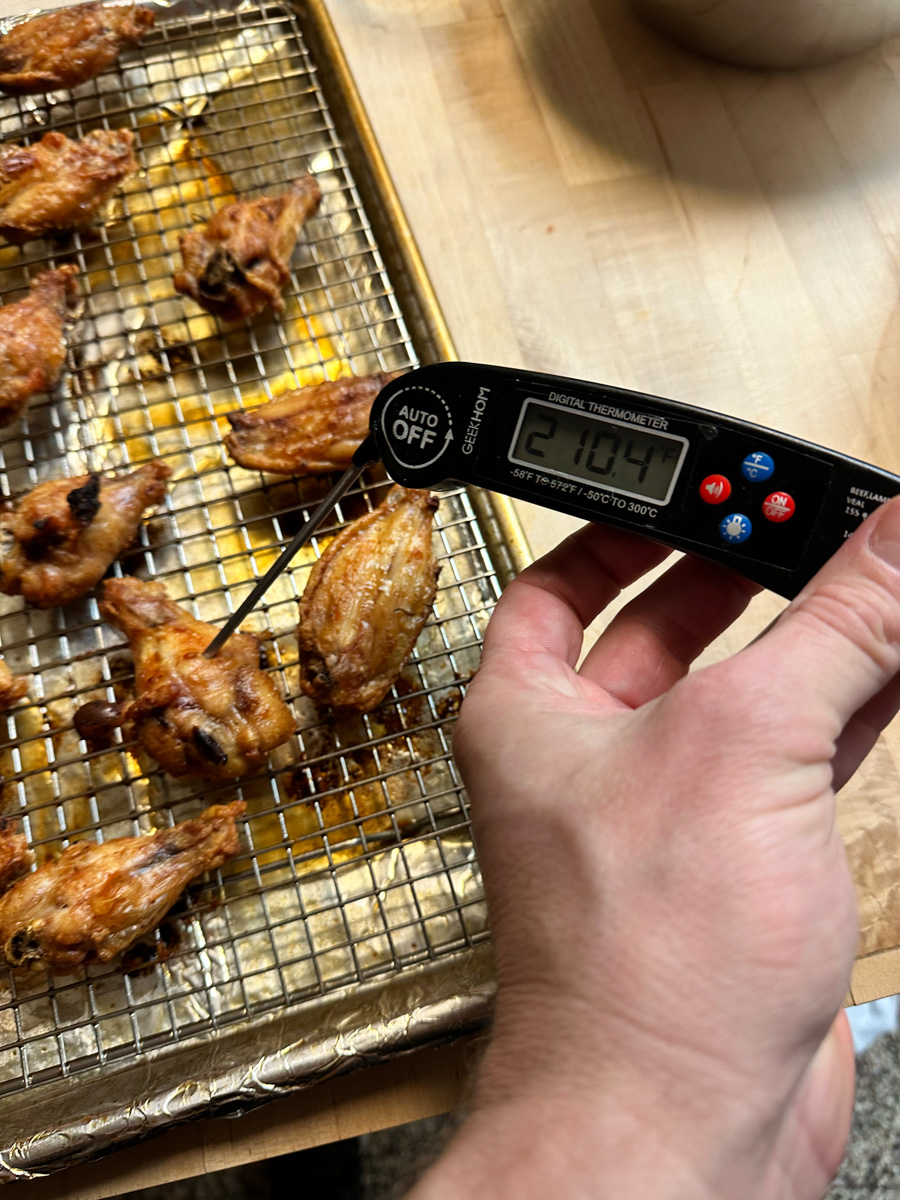
White meat needs to be lower, but for a darker meat like chicken wings, most barbecue guys will tell you that an internal temp of 185-190 is ideal for chicken wings. In this case the thermometer bore out what my eyes were already telling me: these were overdone.
CON:
I set my smoke alarm off a lot. My oven does have particularly paltry venting, but even so, the fat melted off the wing and hit the aluminum foil, and started to burn, smoking the hell out of my kitchen. I spent the whole time apologizing to my baby and dogs.
CON:
Sauce broke a lot. The only guidance the recipe offered on the sauce, which consists of Frank’s Red Hot, melted butter, and sugar, was “Whisk it all together until combined” and then pour over the baked wings. That’s not a lot of tips for an emulsion, and mine broke quite a bit when the hot wings hit them.
The YouTube Recipe — AKA: Gordon Ramsay’s Frenchified Bullshit
Gordon Ramsay’s “Hot Ones Inspired Wings” recipe has 5.6 million views and counting on YouTube. I was actually excited to try this one because it seemed like a unique (to me), potentially great and easy way to make wings.

The Cliff’s Notes:
-Seasoned liberally with garlic powder, smoked paprika, and salt
-Pan fried/butter basted in a pan and then finished in the oven
-Sauced with a mix of “pan sauce,” butter, and “your favorite hot sauce.”

As I said, I was excited to try this one. It’s quicker than the baked recipe and doesn’t require a sheet pan, and seemed to streamline the saucing process. I also finished reading Bill Buford’s latest book about moving to Lyon to learn how to cook French not too long ago, in which Buford basically identifies butter basting as France’s unique contribution to European cuisine (which was otherwise largely invented by the Italians during the Rennaissance). I’d never considered applying it to chicken wings. When I taught myself Peking Duck, it involved using boiling water to pre-render the fat and tighten the duck skin so that it would crisp when baking. This seemed like basically the streamlined, butter-based version of that.
PROS:
Basically, all the stuff mentioned above. A streamlined cooking process.
PRO:
Chef Ramsay measures his butter in “knobs,” which is also British slang for “penis.” I liked the idea of measuring out “four penises of butter.” It’s good to have fun when you cook.
PRO:
The meat came out very moist, much juicier than the baked wings, and almost as moist as the fried ones.
CON:
The smoked paprika-heavy seasoning didn’t really scream “American chicken wings” to me. It was still good, it just had a distinctly European flavor to it and I didn’t like it nearly as much as the other two.
CON:
I wanted this method to work so badly, I actually tried it twice. But it seemed no matter how hot I got my pan, the skin never got very crispy. Letting it soak in all those butter penises, both while basting and baking, and leaving the wings partially submerged while finishing in the oven, seemed to keep the skin on the wings from crisping fully.
Who Wing’d It Better?
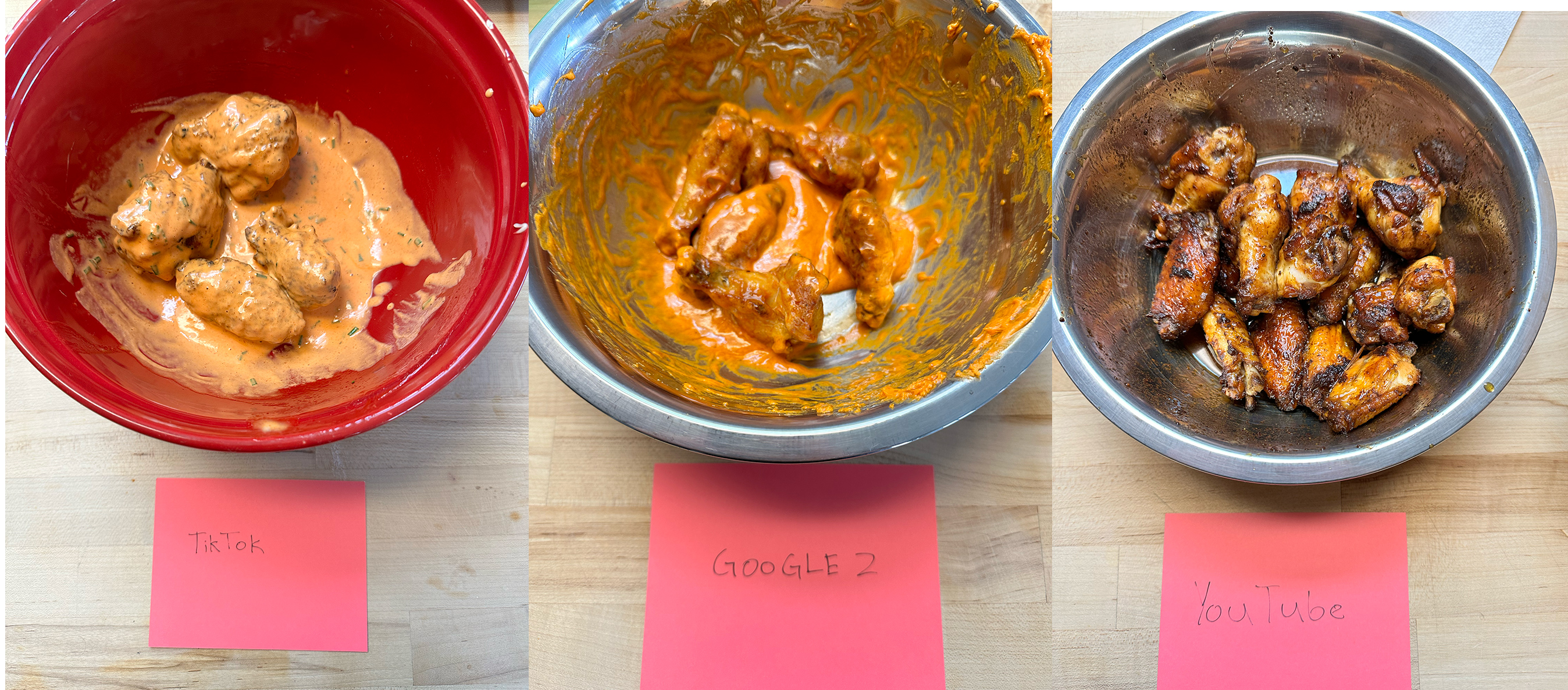
I don’t think you’d throw any of these wing recipes out of bed, but there were pluses and minuses to all of them. The TikTok recipe was crunchy, nicely moist, and with a tasty sauce, but over breaded and impractical for a big group.
The YouTube recipe was also very moist and with a streamlined cooking process, but had flabby skin and the sauce lacked a little of that wingy yumminess (despite requiring the most butter penises).
The Google recipe had nicely rendered skin and roasty flavor and a tasty traditional Buffalo sauce (I tested these on my wife and 9-year-old stepson, and this was my stepson’s favorite), but the meat was dry and overcooked and set my smoke alarm off.
Wing Hack Part 1: Battered And Fried Wings
If you’re committed to doing fried wings (which for the most part, do reward you), this recipe was already pretty good, so it was an easy fix. How do we fix a double-breaded wing that’s too breaded? You guessed it, Einstein, don’t double-bread it.
I found that a single breading worked just fine.
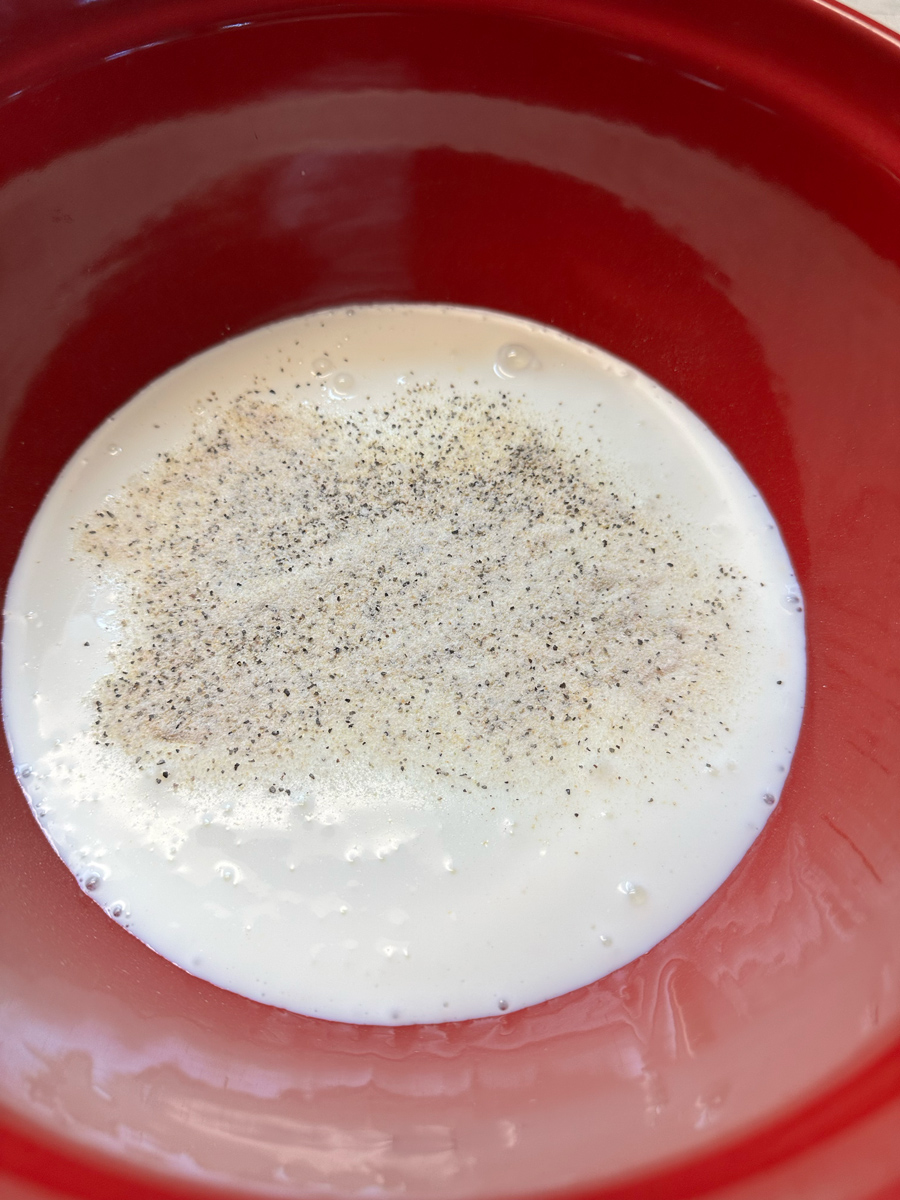
The Soak
- Chicken Wings
- Enough Buttermilk To Cover – I used 2% milk-fat buttermilk.
- About a tablespoon* of your favorite seasoned salt — OR salt, pepper, garlic powder, onion powder.
- *Just taste your marinade before you pour it on the chicken. It should be pretty salty, but not inedibly so. Think pickle juice or seawater and then dial it back a couple notches.
- Leave it to soak overnight.
The Dredge
- About 1/4 cup potato starch
- About 1/4 cup rice flour (corn starch works too if you can’t find it)
- About a teaspoon same seasoning as above
- Whisk it together on a plate, or, if you want to keep it old school, in a paper bag.
- Take your chicken straight out of the marinade, let the excess liquid drain off, roll it around in the dredging mixture (Wet-Dry) — or shake it up in a bag — and set it on a wire rack while you bread the rest.
The Fry
- In a cast iron fry pan, heat peanut oil (what I used), shortening, lard, or whatever oil you’re using to 340 or so, or set your deep fryer t0 315.
- In my cast iron fry pan, I could do about 3-4 wings at a time without the temperature dropping too much (hopefully not below 300)
- Fry for six minutes until golden brown and remove.
- Let rest for 5-10 minutes while you make the sauce.
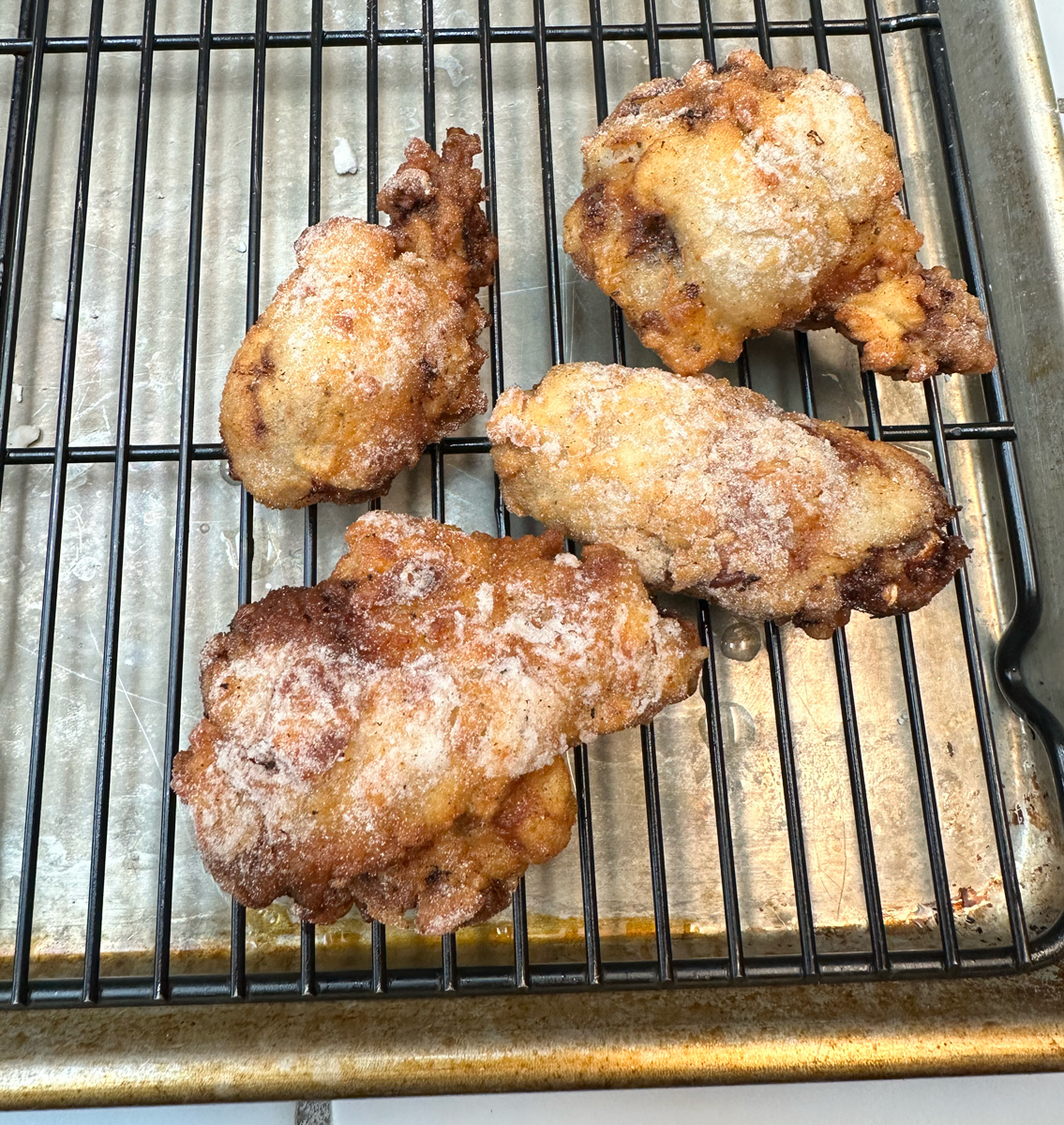
The Sauce
- 1/3 cup Sriracha
- 1/3 cup Kewpie mayo (or regular mayo with a pinch of MSG)
- Squirt of honey (call it a teaspoon)
- Whisk it together.
Fry Part 2
- Set your deep fryer to 375 or heat your pan oil to 380-390.
- Drop your rested wings in 3-4 at a time and fry for 1-2 minutes, removing before they get too much color.
- Rest the wings for another five minutes, then drop them in your sauce, mix, and serve!
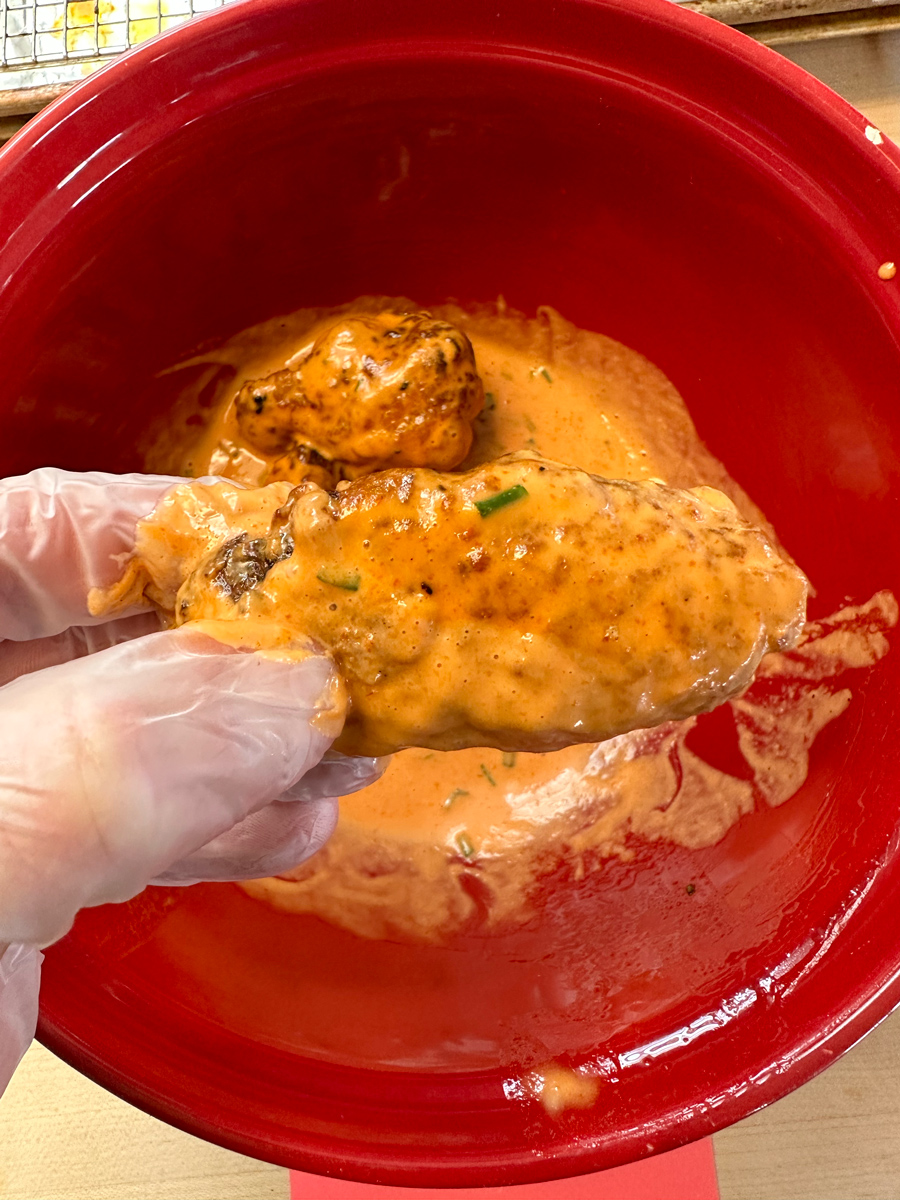
I didn’t mess with this recipe too much because… it was already pretty good! This one definitely has a more Asian feel to it, with the potato starch and the Sriracha, but I think most people who enjoy fried chicken and/or Buffalo wings would love this one. I just dialed back the breading a little.
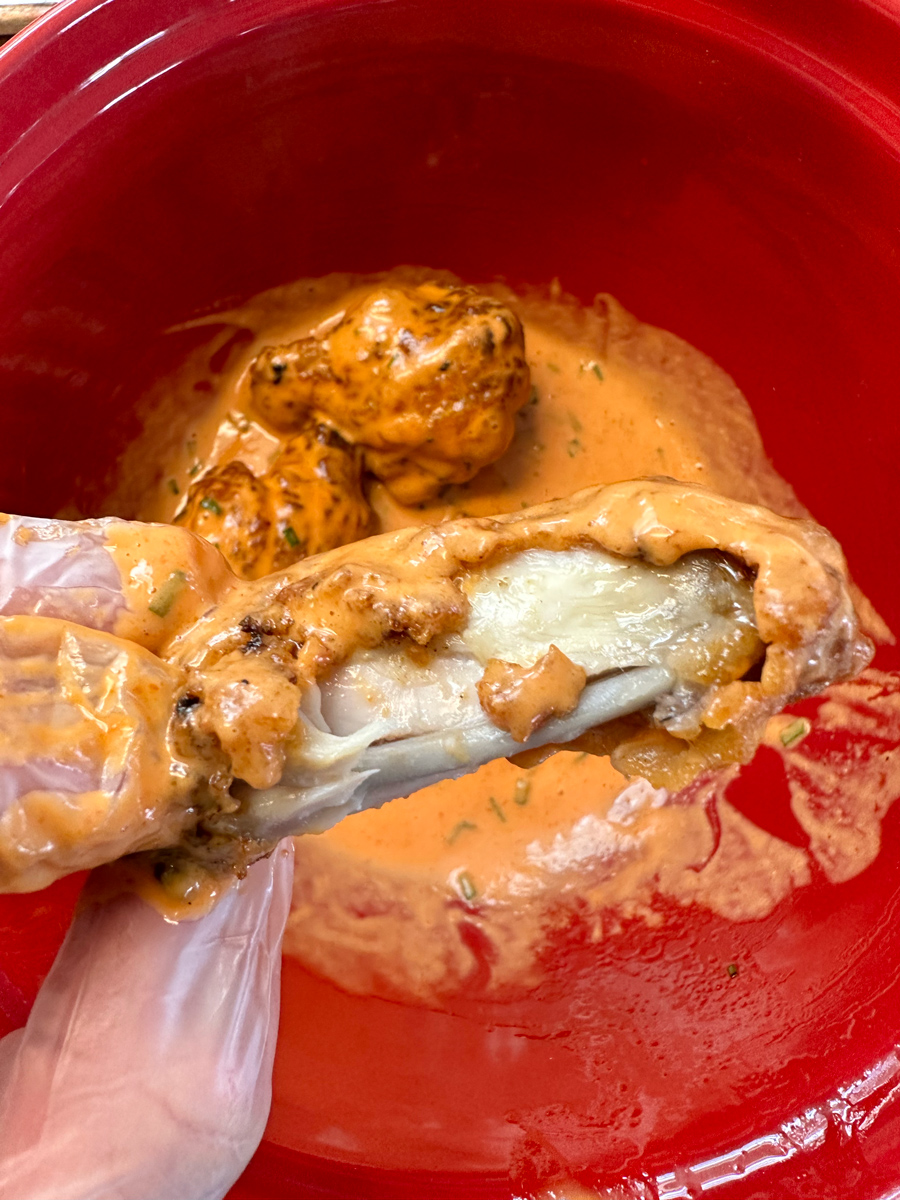
For me this was the ideal amount of breading. Still crunchy, but now I don’t feel like I’m going to die if I eat more than two. The wing did just what Chef Shota described — steamed inside a crispy shell. The chicken comes out super moist, and the batter is crackly-crunchy. In fact probably too crunchy, but with the sauce applied it’s just right.
Wing Hack Part 2: Baked Buffalo Wings
Of the two “baked” wing recipes tested, one came out too dry and the other the skin came out too flabby. I tried to combine the two to see if we could get the best of both worlds. Basically, to the Google recipe, I added a little more baking powder and some corn starch, then I incorporated the YouTube sear and went back to the Google bake for half the cook time.
The Wings
- 4 pounds chicken wings
- 1.5 tablespoons corn starch
- 1.5 tablespoon aluminum-free baking powder
- 1 teaspoon salt
- 2 teaspoons garlic powder
- 2 teaspoons onion powder
- Pinch black pepper (OR, just use your favorite seasoned salt blend)
Put your wings in a bowl. Mix your spices and corn starch/baking powder in a small bowl. Pour the dry mix over the chicken and massage it together. It should create a very light paste on the exterior of the chicken. Refrigerate uncovered overnight.
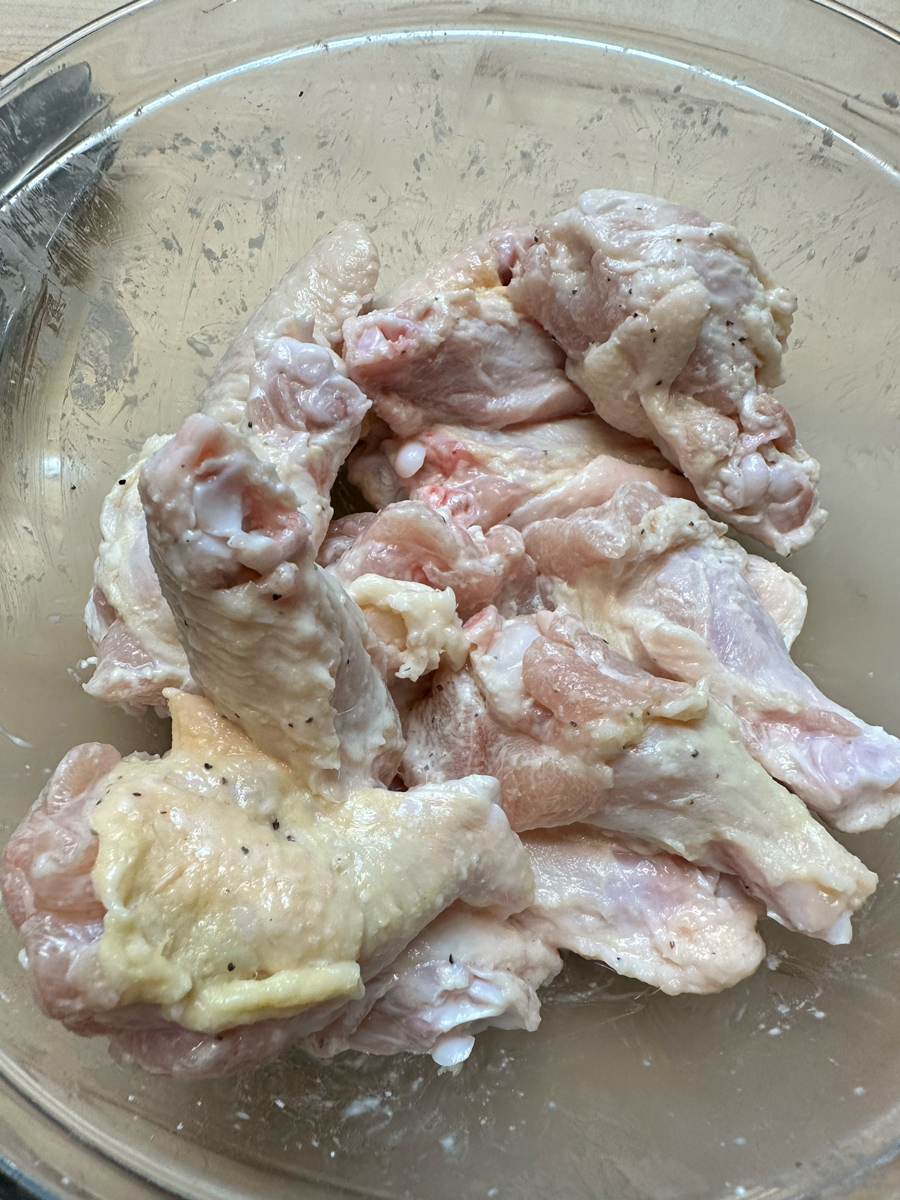
The Cook
- Arrange a sheet pan covered in aluminum foil and put your wire rack on top. Preheat the oven to 450F.
- Heat a thin layer of oil in a pan on the stove at about medium-high.
- Once the oil is almost to smoking, brown the wings in batches.
- A few at a time, put the wings into the hot pan with the oil and turn until well coated. You don’t have to get too much color on them, but you should see the skin visibly tighten — that’s what we’re looking for, a little pre-render.
- Remove them to the wire rack and bake about 10 minutes on each side.
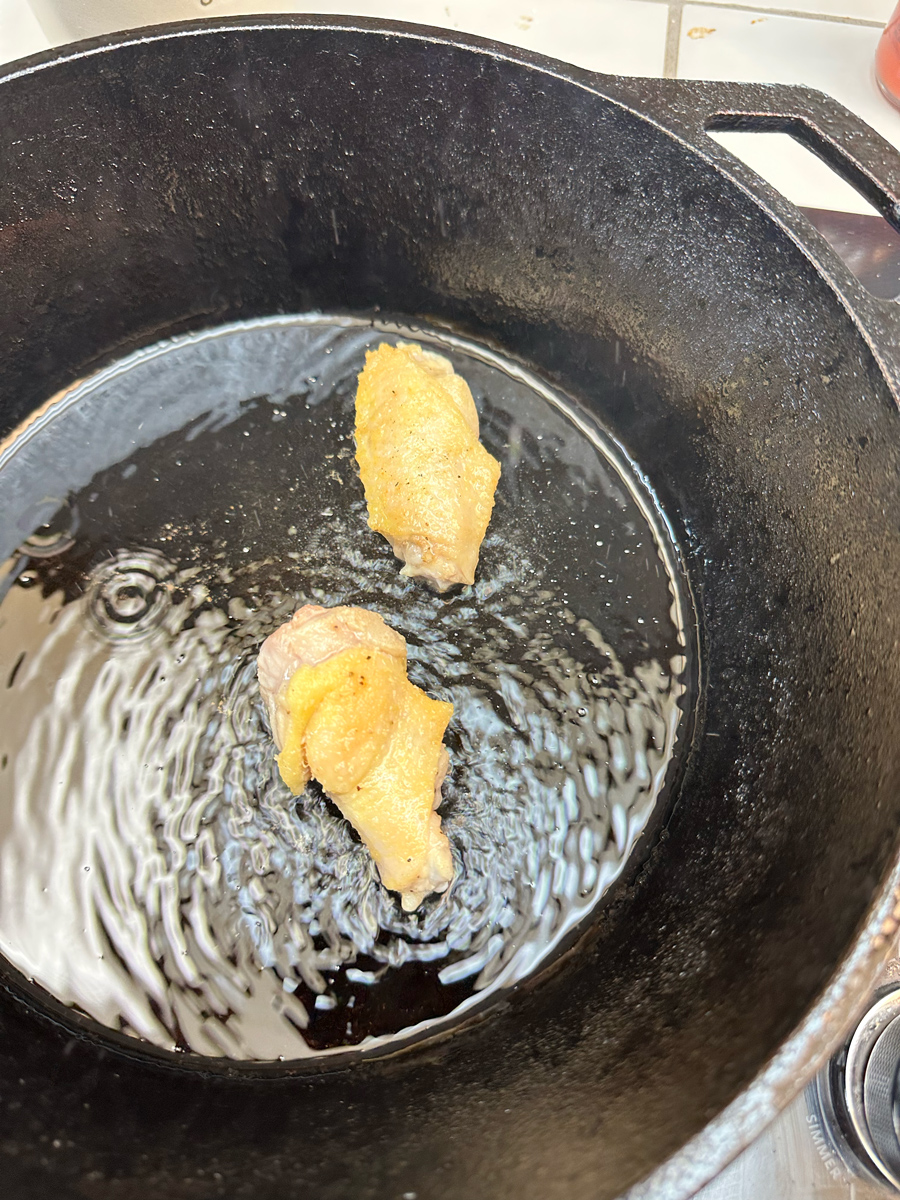
(Yes, after a week of wing testing I was starting to run short on wings).
The Sauce
Traditional Buffalo sauce is delicious. My stepson loved it, even when I couldn’t keep my emulsion from breaking. I’ve read all sorts of tips online for how to keep your Buffalo sauce emulsion from breaking, from using an immersion blender to adding honey. A lot of them didn’t really work.
So I reached out to longtime friend of Uproxx, Michelle Doll, author of Essential Tools, Tips & Techniques for the Home Cook and one-time beater of Bobby Flay to see if she had any suggestions. Doll suggested heating the hot sauce, and then adding the solid butter to that, chunk by chunk, whisking the whole time. That worked great. Ergo…
- 1/2 cup Frank’s Red Hot
- 1/2 cup salted butter
Heat the hot sauce in a pot. Add the butter, a tablespoon or two at a time, to the heated sauce, whisking as you go.
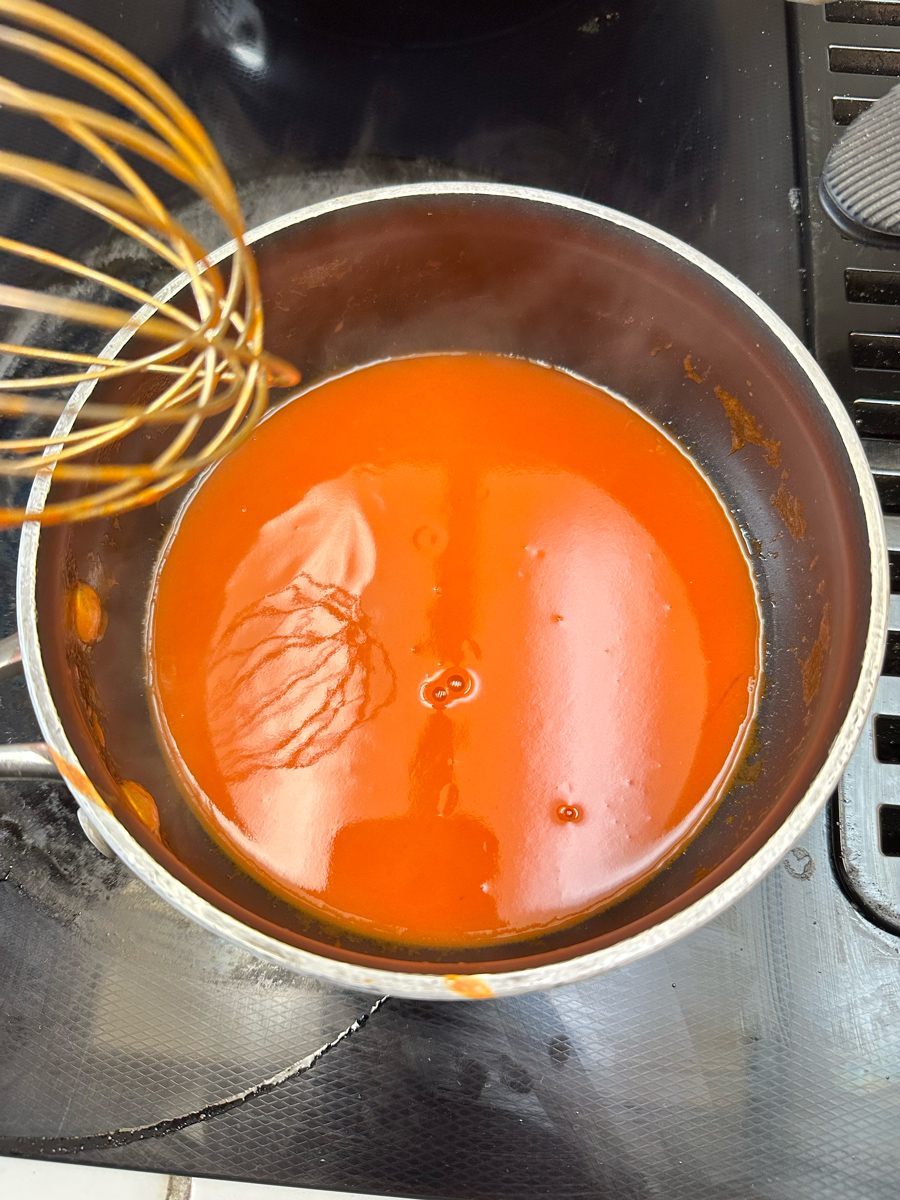
The Finish
Dip your baked wings in the sauce, return to the wire rack, turn the oven down to 350F and bake for five more minutes.
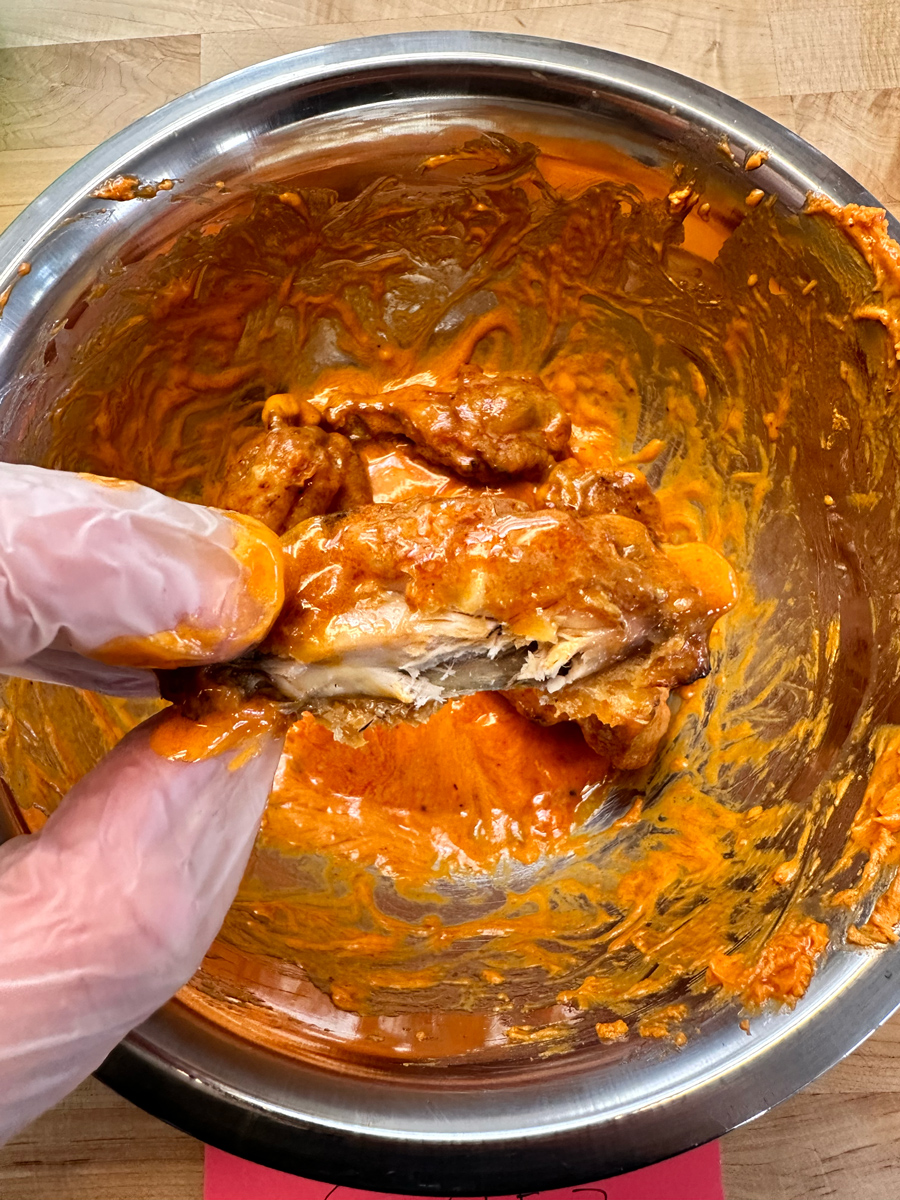
This seemed to give the wings a nice balance of crunchy, roasty, rendered-fat flavor from the pan-prepping, but a much moister, juicier interior thanks to the reduced cooking time. Was it as good as the fried wings? Well, I don’t know if anything is better than a deep-fried wing, but these were easier, with less cleanup, and I could cook a lot more at a time.
I think the breaded, deep-fried wings were a shade better, but I would put these up against unbreaded fried wings any day!
Vince Mancini is on Twitter. You can read more of his recipes here.
